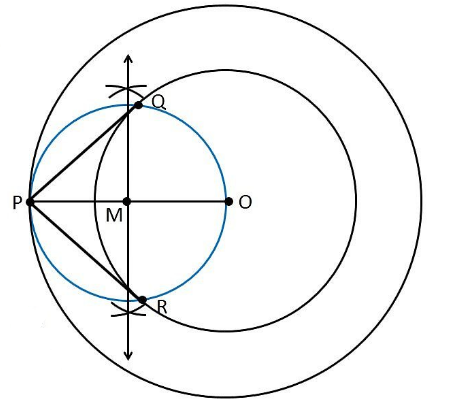Construct a tangent to a circle of radius 4 cm from a point on the concentric circle of radius 6 cm and measure its length. Also verify the measurement by actual calculation.
Construction Procedure:
The tangent for the given circle can be drawn as follows:
1. Draw a circle with a radius of 4 cm and with “O” as the centre.
2. Taking O as the centre, draw a circle with a radius of 6 cm.
3. On this circle, locate a point P.
4. Join the points O and P using lines so that it becomes OP.
5. To the line OP, draw a perpendicular bisector.
6. Assume M is the midpoint of PO.
7. Draw a circle with the centre M and the radius MO.
8. At the points Q and R, the circle drawn with the radius OM intersects the given circle.
9. Now join PQ and PR.
10. The required tangents are PQ and PR.
PQ and PR have a length of 4.47 cm each, according to the construction.
It is possible to calculate it manually as follows:
Now in ∆PQO,
As we know PQ is a tangent,
∠PQO = 90°. PO = 6cm and QO = 4 cm
In ∆PQO using the Pythagoras theorem, we obtain PQ2+QO2 = PQ2
PQ2+(4)2 = (6)2
PQ2 +16 =36
PQ2 = 36−16
PQ2 = 20
PQ = 2√5
PQ = 4.47 cm
As a result, the tangent length PQ = 4.47

Justification:
The given problem’s construction can be justified by demonstrating that PQ and PR are tangents to a circle of radius 4 cm with centre O.
To prove, join the dotted lines representing OQ and OR.
From the above construction,
In the semi-circle ∠PQO is an angle.
As we know that the angle in a semi-circle is a right angle, therefore
∠PQO = 90°
As a result
⇒ OQ ⊥ PQ
PQ must be a tangent of the circle since OQ is the radius of the circle of measure 4 cm. We can now similarly prove that PR is a tangent to the circle.
As a result, the above construction is justified.
